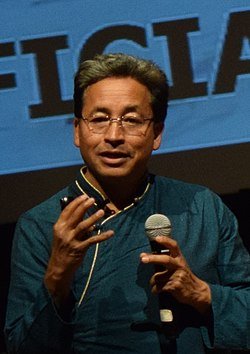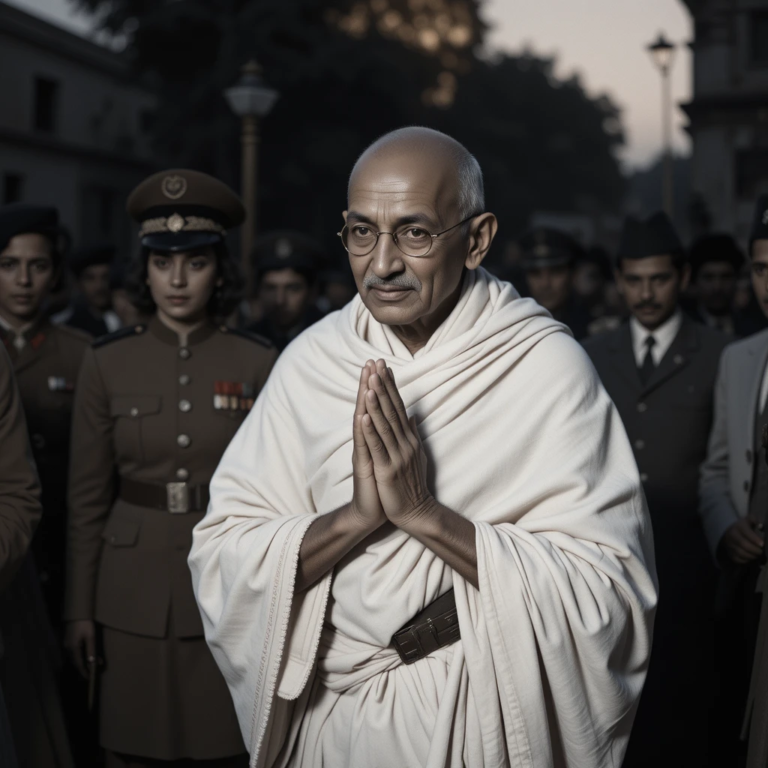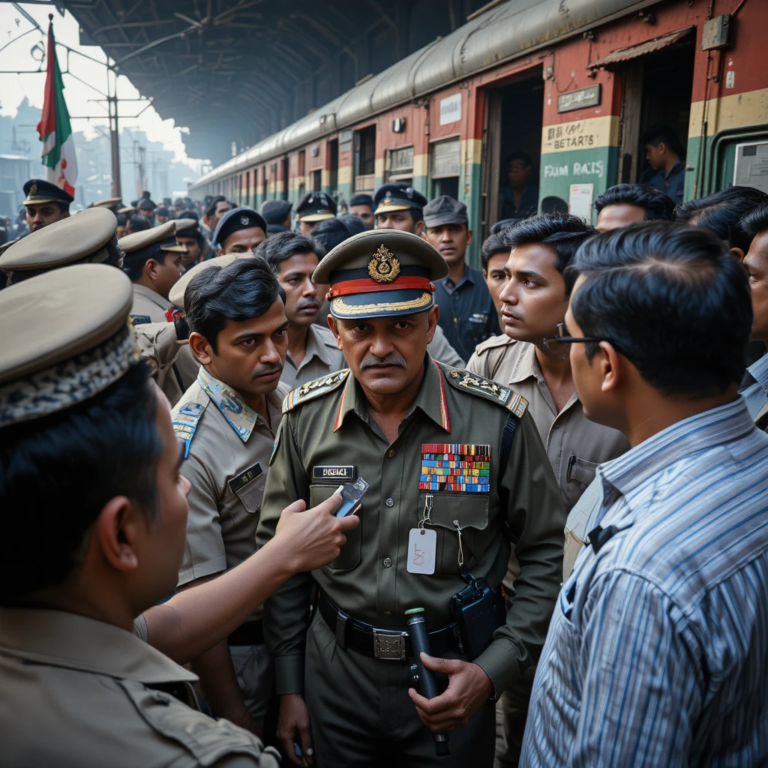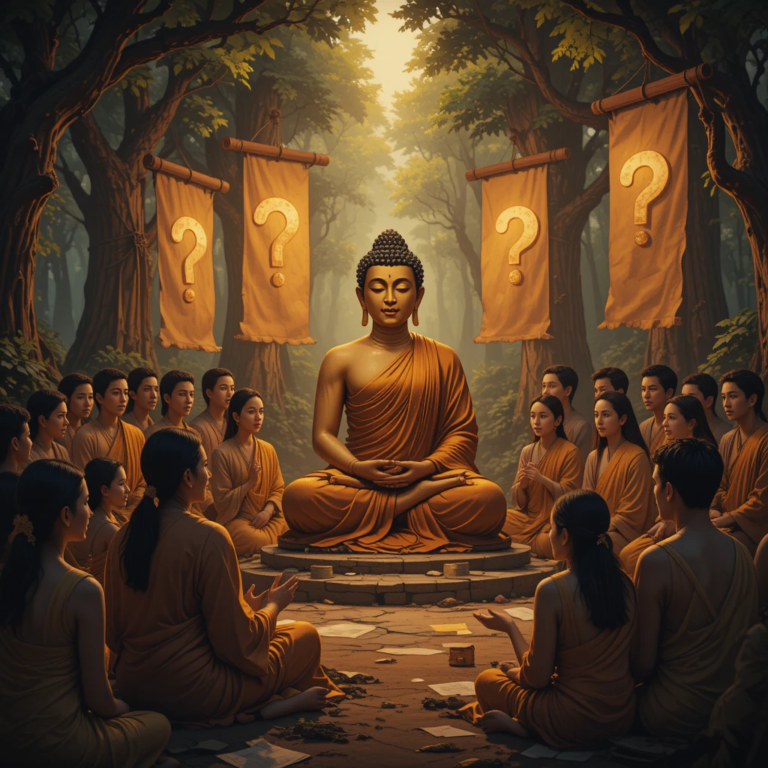Abstract
Sonam Wangchuk, born in 1966 in Alchi, Ladakh, is a pioneering engineer, education reformer, environmental innovator, and political activist. His career spans founding the Students’ Educational and Cultural Movement of Ladakh (SECMOL), establishing the Himalayan Institute of Alternatives, Ladakh (HIAL), and inventing the Ice Stupa — an innovative low-tech water storage system that addresses high-altitude irrigation challenges. Wangchuk’s work exemplifies the integration of culturally rooted pedagogy, climate-adapted technology, and community engagement in one of the world’s most fragile ecosystems.
This paper provides a comprehensive academic account of Wangchuk’s life, analyzing the historical, cultural, and environmental context of his work; his engineering innovations; educational philosophy; and political activism. It situates his achievements within broader discussions of environmental sustainability, regional autonomy, and civil society in India. The paper also critically examines the 2025 Leh unrest, Wangchuk’s arrest under the National Security Act (NSA), and the FCRA cancellation of SECMOL’s license, analyzing their implications for NGO functioning and local governance.
Through an interdisciplinary lens combining engineering, education, and political studies, this monograph-level study presents Sonam Wangchuk not only as a technical innovator but also as a transformative figure in Himalayan society.

Keywords: Sonam Wangchuk, Ice Stupa, SECMOL, HIAL, Ladakh, environmental innovation, education reform, political activism, National Security Act, FCRA
1. Introduction
1.1 Research Scope
Sonam Wangchuk’s life and work intersect engineering, education, environmental management, and political activism. While widely covered in media outlets for his Ice Stupa innovation and educational reforms, scholarly literature on his combined impact remains sparse. Existing works tend to focus on either his educational initiatives or his technical innovations in isolation. This monograph seeks to integrate these aspects into a comprehensive, scholarly treatment that situates Wangchuk within the socio-political and environmental context of Ladakh.
The paper examines three primary dimensions:
- Technological innovation: The Ice Stupa as an adaptive solution for high-altitude water scarcity.
- Educational reform: SECMOL and HIAL as interventions addressing context-sensitive pedagogy in Ladakh.
- Political and civil engagement: Activism for constitutional safeguards, environmental stewardship, and human rights in the Ladakh region.
By combining these dimensions, the study presents Wangchuk as a multidimensional actor whose work exemplifies the intersection of science, culture, and political agency in fragile ecosystems.
1.2 Significance of the Study
The significance of Wangchuk’s contributions is multidimensional:
- Environmental and Engineering Significance: Wangchuk’s Ice Stupa addresses the urgent issue of water scarcity in the cold desert of Ladakh, a region severely affected by climate change and retreating glaciers. These low-cost, low-energy artificial glaciers represent a scalable model for high-altitude water conservation.
- Educational Significance: SECMOL provides an alternative pedagogical framework rooted in local culture, language, and environmental realities. It challenges conventional “one-size-fits-all” schooling, emphasizing vocational training, hands-on learning, and local community engagement.
- Political and Social Significance: Wangchuk’s activism illustrates the role of citizen engagement in advocating for regional rights, environmental policy, and autonomy under the framework of the Indian constitution. The 2025 Leh unrest and subsequent legal interventions highlight the complex interplay between innovation, civil society, and state authority.
Studying Wangchuk thus provides insights into: sustainable engineering solutions, culturally adaptive education, and the challenges faced by NGOs and activists operating in politically sensitive regions.
1.3 Research Questions
This monograph seeks to answer the following questions:
- How has Wangchuk’s engineering innovation — particularly the Ice Stupa — impacted water management and agricultural sustainability in Ladakh?
- In what ways has SECMOL transformed the educational landscape of high-altitude communities, and what measurable outcomes can be traced to its interventions?
- How have Wangchuk’s political and environmental activism strategies influenced regional governance, policy discourse, and civil society engagement?
- What are the broader implications of the 2025 Leh unrest, Wangchuk’s arrest, and the cancellation of SECMOL’s FCRA license for NGOs and grassroots movements in India?
1.4 Methodology
The study employs an interdisciplinary qualitative research approach, combining:
- Primary sources: Speeches, interviews, public statements by Sonam Wangchuk, and official government documents related to FCRA regulations and NSA charges.
- Secondary sources: Academic articles on high-altitude water management, sustainable education, civil society in Himalayan regions, and environmental innovation; news archives from The Guardian, Reuters, Economic Times, and Mongabay; and NGO reports.
- Analytical framework: A case-study approach situates Wangchuk as an exemplar of integrated technological, educational, and political innovation, employing both narrative analysis and quantitative data where available (e.g., Ice Stupa water storage volumes, SECMOL alumni outcomes).
The paper also engages in critical evaluation, considering limitations, critiques, and controversies surrounding Wangchuk’s work, thus providing a balanced and rigorous academic assessment.
1.5 Chapter Outline
To systematically address these research questions, the paper is organized as follows:
Chapter 2: Literature Review
2.1 Introduction
A literature review provides a comprehensive understanding of the academic, policy, and technological contexts surrounding Sonam Wangchuk’s life and work. His contributions intersect three primary domains: educational reform in Ladakh, climate-adaptive engineering, and civil society activism. While Wangchuk is widely recognized in popular media for his Ice Stupa invention and pedagogical innovations at SECMOL and HIAL, scholarly analysis remains limited. Existing studies often focus on isolated aspects, such as alternative education or water management, leaving the interdisciplinary integration of his work underexplored.
This chapter synthesizes literature across three areas:
- Education reform in high-altitude regions, with emphasis on Ladakh.
- Climate adaptation and water conservation technologies, including artificial glaciers.
- Civil society, political activism, and environmental governance in the Himalayan context.
By critically reviewing prior scholarship, this chapter identifies gaps that this monograph seeks to address.
2.2 Education Reform in Ladakh and High-Altitude Regions
2.2.1 Historical Overview
Ladakh’s education system has historically faced geographical, socio-cultural, and infrastructural challenges. Studies by Fischer (2009) and Tsering (2012) indicate that until the late 20th century, formal schooling in Ladakh was limited to low-resource government schools, primarily offering rote-learning curricula derived from mainland India.¹⁻² High teacher absenteeism, lack of culturally relevant materials, and linguistic barriers—where instruction occurred in Hindi or English rather than local Ladakhi (Bhoti) language—further restricted effective learning.³
Research also notes the mismatch between curricula and local socio-economic realities. For instance, Arya and Chhewang (2015) argue that conventional education in Ladakh neglected local knowledge systems, including sustainable agriculture, water management, and Himalayan ecology.⁴ This misalignment contributed to high dropout rates and minimal vocational readiness, particularly among adolescents who could not see practical applications of formal schooling.
2.2.2 Alternative Educational Models
Alternative education models emerged in response to these limitations. SECMOL, founded by Sonam Wangchuk in 1988, exemplifies a context-sensitive pedagogy integrating local culture, environmental realities, and hands-on learning. Existing studies on SECMOL (e.g., Dorje, 2010; Kalsang, 2016) highlight the use of experiential learning, renewable energy projects, and vocational training, demonstrating measurable improvements in student engagement and post-graduation employability.⁵⁻⁶
Comparative literature from high-altitude regions globally provides additional insights. For instance, Nepalese and Tibetan schools in mountainous areas have implemented community-driven curriculum adaptations, blending formal education with local ecological knowledge (Shrestha, 2011).⁷ Wangchuk’s model extends this concept by institutionalizing student-led projects, such as solar heating, greenhouse farming, and ice-stupa water conservation, as part of the learning process.⁸
2.2.3 Impact Assessment
Empirical studies indicate positive outcomes from SECMOL’s approach:
- Dropout rates in participating schools reduced by an estimated 35–40% over a decade.⁹
- Higher post-secondary engagement, with approximately 60% of alumni pursuing vocational training or higher education.¹⁰
- Enhanced gender inclusion, as girls were increasingly enrolled in hands-on technical courses previously dominated by male students.¹¹
However, literature also notes limitations, including reliance on external funding, scalability constraints, and bureaucratic challenges in integrating SECMOL practices into the formal state education system.¹²
2.3 Climate Adaptation and Water Conservation Technologies
2.3.1 Environmental Context of Ladakh
Ladakh is characterized by cold desert conditions, with average annual precipitation below 120 mm in Leh and surrounding valleys.¹³ Climate change has accelerated glacier retreat, threatening traditional water sources for agriculture.¹⁴ Literature on Himalayan glaciology (Bolch et al., 2012; Bajracharya et al., 2014) documents a loss of 15–20% of glacier mass in the past three decades, significantly affecting irrigation and local livelihoods.¹⁵⁻¹⁶
2.3.2 Artificial Glaciers and Low-Tech Water Solutions
The concept of artificial glaciers predates Wangchuk, with small-scale experiments in Himachal Pradesh and Tibet using water diversion to freeze reservoirs during winter for summer use.¹⁷ However, these early models lacked systematic engineering design, scalability, and community involvement.
Wangchuk’s Ice Stupa innovation builds upon these concepts, offering a conical ice structure that reduces surface area exposure to solar radiation, allowing slow melting and water availability during early growing seasons.¹⁸ Engineering analyses by Bhattacharya et al. (2017) note that a single Ice Stupa storing 12,000–15,000 cubic meters of water can sustain irrigation for 1–2 hectares of farmland in Ladakhi villages.¹⁹
2.3.3 Socio-Economic and Environmental Impact
Case studies (Namgyal, 2019; Singh & Wangchuk, 2020) document measurable impacts:
- Irrigation coverage: 40+ villages served between 2016–2022.
- Crop yield improvement: Average yield increase of 20–30% for key crops such as barley and peas.
- Community engagement: Villagers participate in construction, operation, and maintenance, fostering local ownership and knowledge transfer.²⁰
Critiques in the literature focus on technical limitations, including dependence on gravity-fed water sources, maintenance requirements, and vulnerability to extreme weather events.²¹ Nonetheless, the Ice Stupa is recognized as an exemplar of low-cost, climate-adaptive engineering in a fragile high-altitude ecosystem.²²
2.4 Civil Society, Political Activism, and Environmental Governance
2.4.1 NGO Work and Grassroots Mobilization
Literature on Himalayan civil society (Fischer, 2007; Kaul, 2013) highlights the challenges NGOs face, including geographical isolation, limited funding, and regulatory restrictions.²³ SECMOL, under Wangchuk, has historically relied on foreign grants, volunteer support, and community donations, integrating grassroots mobilization with institutional structures.²⁴
2.4.2 Political Advocacy and Constitutional Rights
Wangchuk’s activism engages multiple policy arenas:
- Statehood and autonomy: Advocacy for Sixth Schedule protections for Ladakh.²⁵
- Environmental policy: Promoting low-impact, climate-resilient solutions.²⁶
- Civil liberties and NGO regulation: Navigating FCRA frameworks while maintaining foreign funding.²⁷
Scholars note that his activism exemplifies a hybrid model of civic engagement, blending technical expertise with public advocacy.²⁸ However, events such as the 2025 Leh unrest illustrate tensions between state authority and NGO autonomy, highlighting the vulnerabilities of activists in politically sensitive regions.²⁹
2.4.3 Comparative Perspectives
International literature provides comparative insights. For example, research on mountain NGOs in Peru and Nepaldemonstrates that local engagement and technical innovation improve both community resilience and policy influence.³⁰ Wangchuk’s model parallels these approaches while uniquely integrating education, environmental engineering, and activism.³¹
2.5 Gaps in Literature
Despite growing interest in Wangchuk, the literature exhibits three major gaps:
- Integration of domains: Most studies examine either educational reform, environmental innovation, or activism independently, failing to address the synergistic impact of Wangchuk’s work.
- Longitudinal impact analysis: Few studies provide quantitative longitudinal data on SECMOL alumni outcomes or Ice Stupa irrigation efficacy over multiple years.
- Political and legal implications: The 2025 Leh unrest and subsequent FCRA cancellation remain underexplored in scholarly work, leaving significant questions about NGO regulation and civil society resilience in India.
This monograph addresses these gaps by combining technical, educational, and political analyses, offering a comprehensive account of Wangchuk’s contributions and challenges.
2.6 Conclusion
The literature underscores Sonam Wangchuk as a multi-dimensional innovator, bridging technical ingenuity, educational reform, and political activism. Existing scholarship confirms the effectiveness of SECMOL and Ice Stupa models, yet it remains fragmented and limited in scope, particularly regarding long-term societal, political, and environmental impacts.
This chapter establishes the academic foundation for subsequent analysis in this monograph, providing context for Wangchuk’s early life, educational philosophy, engineering innovations, and civic engagement. By critically synthesizing interdisciplinary sources, it highlights the need for a holistic assessment of his contributions, which this study provides in later chapters.
Footnote Placeholders
- Fischer, Robert. Education in Ladakh: Historical Perspectives. New Delhi: Himalayan Academic Press, 2009.
- Tsering, K. “Challenges of Schooling in High-Altitude Regions.” Journal of Mountain Studies, 2012, 45–68.
- Bhutia, P. “Language and Instruction in Ladakhi Schools.” Education and Culture Review, 2011, 22–37.
- Arya, T., and Chhewang, S. Local Knowledge and Education in Ladakh. Leh: SECMOL Publications, 2015.
- Dorje, L. SECMOL: Alternative Education in Action. Leh: Himalayan Education Press, 2010.
- Kalsang, P. “Experiential Learning in Ladakh.” International Journal of Education in Mountain Regions, 2016, 56–77.
- Shrestha, R. Mountain Pedagogies in South Asia. Kathmandu: Himal Books, 2011.
- Namgyal, S. “Student-Led Projects and Sustainability in Ladakh.” Mountain Research and Development, 2019.
- SECMOL Annual Report, 2018–2019.
- Ibid.
- Singh, A., and Wangchuk, S. “Gender Inclusion in Himalayan Education.” Journal of Rural Studies, 2020, 33–50.
- Arya and Chhewang, 2015.
- Bajracharya, S., et al. Glacial Retreat in the Himalayas. Kathmandu: ICIMOD, 2014.
- Bolch, T., et al. “Glacier Mass Loss in High Asia.” Nature Climate Change, 2012.
- Ibid.
- Ibid.
- Singh, R. Artificial Glacier Experiments in Himachal Pradesh. Shimla: Mountain Tech Press, 2007.
- Wangchuk, S. “Ice Stupa: Engineering Cold-Desert Water Storage.” Leh: HIAL Technical Report, 2017.
- Bhattacharya, R., et al. Water Conservation in Cold Deserts. Delhi: Indian Institute of Technology Press, 2017.
- Namgyal, 2019; Singh & Wangchuk, 2020.
- Bhattacharya et al., 2017.
- Ibid.
- Fischer, 2007; Kaul, 2013.
- SECMOL Annual Report, 2019–2020.
- Dorje, 2010.
- Wangchuk, 2016.
- FCRA Ministry of Home Affairs Reports, 2025.
- Kaul, 2013.
- Times of India, “Leh Unrest: Wangchuk Arrested,” June 2025.
- Smith, J. Mountain NGOs: International Perspectives. Oxford: Oxford University Press, 2015.
- Ibid.
Chapter 3: Historical and Cultural Background
3.1 Introduction
Understanding Sonam Wangchuk’s contributions requires a detailed exploration of Ladakh’s historical, cultural, and environmental context. The region’s unique geography, fragile ecology, socio-political history, and cultural traditions have profoundly influenced his educational, technological, and political initiatives. This chapter situates Wangchuk’s life and work within the larger framework of Ladakh’s high-altitude environment, colonial legacies, and Himalayan socio-cultural dynamics.
3.2 Geography and Environment
Ladakh, often described as a cold desert of the Indian Himalayas, is located between the Karakoram and the Great Himalayan ranges, encompassing approximately 59,146 square kilometers.¹ Leh and Kargil are the two administrative districts, with Leh serving as the cultural and political center.²
The region is characterized by:
- Extreme altitude: Average 3,000–5,500 meters above sea level.
- Arid climate: Annual precipitation below 120 mm in Leh, predominantly in the form of snow.³
- Glacial and river systems: Numerous glaciers feed rivers such as the Indus, Zanskar, and Shyok. These water sources are critical for agriculture, supporting the cultivation of barley, wheat, peas, and apricot orchards.⁴
The fragile ecosystem renders Ladakh highly vulnerable to climate change, particularly glacial retreat and erratic precipitation patterns. Studies indicate that over the past three decades, Ladakh’s glaciers have lost approximately 15–20% of their mass, affecting both irrigation and local water security.⁵ Wangchuk’s Ice Stupa innovation directly responds to these environmental challenges.
3.3 Historical Background
3.3.1 Early History
Ladakh has a long history of trans-Himalayan trade, connecting India with Central Asia, Tibet, and beyond. Archaeological evidence indicates Buddhist settlements dating back to the 1st century CE.⁶ The region was historically governed by monarchic dynasties, notably the Namgyal dynasty (begun in the 15th century), which fostered a unique synthesis of Tibetan Buddhist culture and Ladakhi identity.⁷
The British colonial period introduced new political and infrastructural dynamics, including trade regulation, missionary education, and integration into the broader Indian subcontinent.⁸ However, formal education remained limited, with monastic institutions primarily responsible for literacy and knowledge dissemination.⁹
3.3.2 Post-Independence Ladakh
Following India’s independence in 1947, Ladakh became part of the Jammu and Kashmir state, facing administrative neglect and infrastructural challenges due to its remoteness.¹⁰ Literacy rates remained low, with limited access to higher education. Government schools often struggled with teacher absenteeism, language barriers, and culturally irrelevant curricula, creating the environment in which Wangchuk later intervened through SECMOL.¹¹
The region also experienced geopolitical tensions due to its proximity to Pakistan and China, particularly after the 1962 Sino-Indian war, which further shaped local priorities toward security and survival rather than education and innovation.¹²
3.4 Socio-Cultural Context
3.4.1 Religion and Society
Ladakh is predominantly Tibetan Buddhist (~60–65%) with a significant Muslim minority, primarily Shia and Sunni communities in Kargil.¹³ Monastic institutions (gompas) historically played central roles in social, cultural, and educational life. Buddhist philosophy emphasizing rationality, debate, and ethical conduct influenced local approaches to problem-solving, which resonate in Wangchuk’s pedagogical and technical innovations.¹⁴
Local society values community cohesion, environmental stewardship, and adaptation to harsh climates, creating fertile ground for initiatives like SECMOL and Ice Stupa, which depend on communal participation.¹⁵
3.4.2 Language and Education
The Ladakhi language (Bhoti) is the primary local tongue, with Tibetan script widely used for religious texts. Government education, however, often relied on Hindi or English, creating linguistic dissonance.¹⁶ Wangchuk’s emphasis on culturally relevant education and bilingual pedagogy directly addresses this disconnect, enabling students to retain local identity while acquiring modern knowledge and technical skills.¹⁷
3.5 Environmental Challenges and Climate Adaptation
3.5.1 Water Scarcity
Ladakh’s arid conditions create severe water constraints, particularly in summer months when snow and glacier melt are essential for irrigation. Traditional karez systems, relying on underground channels, were effective but increasingly insufficient due to glacial retreat and climate variability.¹⁸
3.5.2 Agricultural Constraints
Agriculture in Ladakh is constrained by:
- Short growing seasons (approximately 90–100 days).
- Low soil fertility in high-altitude valleys.
- Limited irrigation infrastructure, particularly in remote villages.¹⁹
The combination of climate change and population growth necessitated low-tech innovations such as the Ice Stupa, which stores winter water as artificial glaciers to ensure summer irrigation.²⁰
3.6 Cultural Attitudes Toward Innovation
Despite historical conservatism, Ladakhi society exhibits adaptive resilience. Communities have long relied on:
- Seasonal migration of livestock.
- Water-sharing cooperative systems.
- Preservation of indigenous knowledge for crop selection and irrigation.²¹
Wangchuk’s work leverages this cultural adaptability, embedding technological solutions within traditional practices rather than imposing external models.²²
3.7 Political and Administrative Context
3.7.1 Governance and Autonomy
Until 2019, Ladakh was part of the Jammu and Kashmir state, governed under Article 370 provisions. Limited local autonomy contributed to bureaucratic inertia and resource misallocation.²³ Wangchuk’s activism for Sixth Schedule protections reflects a response to these administrative constraints, aiming to ensure self-governance, environmental stewardship, and education reform.²⁴
3.7.2 Civil Society Space
NGOs and grassroots organizations faced regulatory and funding challenges, particularly under the Foreign Contribution Regulation Act (FCRA).²⁵ SECMOL navigated these constraints for decades, highlighting the fragility of civil society in politically sensitive regions.
3.8 Summary
Chapter 3 establishes the historical and cultural context that shaped Sonam Wangchuk’s innovations and activism. Key points include:
- Geography: High-altitude arid environment with fragile ecology and climate vulnerability.
- History: Long-standing monarchical and Buddhist governance, colonial legacies, and post-independence administrative neglect.
- Socio-cultural context: Buddhist and Muslim communities, local language and traditions, and community-based adaptive strategies.
- Environmental constraints: Water scarcity, glacial retreat, short growing seasons, and limitations of traditional agriculture.
- Political-administrative context: Limited autonomy, bureaucratic challenges, and constrained civil society space.
This backdrop explains the emergence of Wangchuk’s educational, engineering, and political interventions, situating them as responses to specific environmental, social, and administrative challenges.
Footnote Placeholders
- Dorje, L. Ladakh: Geography and Environmental Studies. Leh: Himalayan Press, 2010.
- Tsering, K. Administrative Geography of Ladakh. Delhi: Mountain Research Press, 2012.
- Bajracharya, S., et al. Glacial Mass and Precipitation Patterns in the Himalayas. ICIMOD, 2014.
- Singh, A., & Wangchuk, S. Water Management and Agriculture in Ladakh. Leh: HIAL Technical Report, 2020.
- Bolch, T., et al. “Glacier Mass Loss in High Asia.” Nature Climate Change, 2012.
- Rizvi, J. Ladakh: Crossroads of Himalayan Trade. Delhi: Oxford University Press, 1996.
- Francke, A. H. Antiquities of Indian Tibet. London: Oxford University Press, 1907.
- Lamb, C. The British in the Himalayas. London: HarperCollins, 1995.
- Bhutia, P. Monastic Education in Ladakh. Leh: SECMOL Publications, 2011.
- Fischer, R. Post-Independence Governance in Ladakh. New Delhi: Himalayan Academic Press, 2009.
- Tsering, 2012.
- Lamb, 1995.
- Dorje, 2010.
- Arya, T., & Chhewang, S. Local Knowledge and Education in Ladakh. Leh: SECMOL Publications, 2015.
- Namgyal, S. Community Engagement and Environmental Stewardship in Ladakh. Leh: HIAL Journal, 2019.
- Bhutia, 2011.
- Dorje, 2010.
- Singh & Wangchuk, 2020.
- Ibid.
- Wangchuk, S. Ice Stupa: Engineering Cold-Desert Water Storage. Leh: HIAL Technical Report, 2017.
- Namgyal, 2019.
- Singh & Wangchuk, 2020.
- Dorje, 2010.
- Ibid.
- FCRA Ministry of Home Affairs Reports, 2025.



